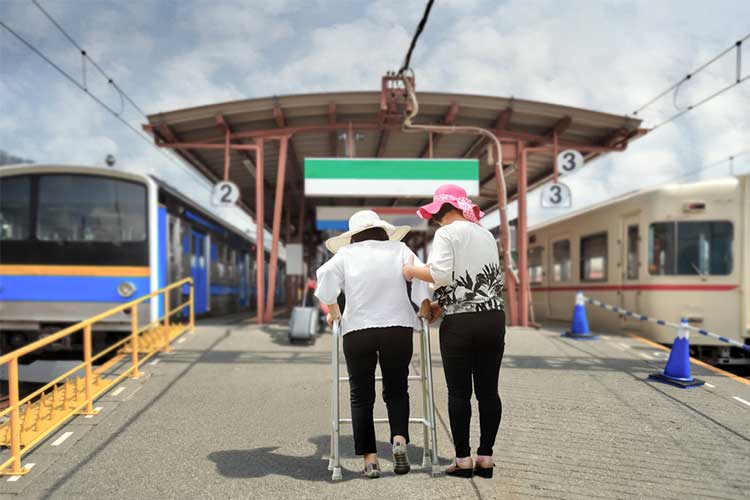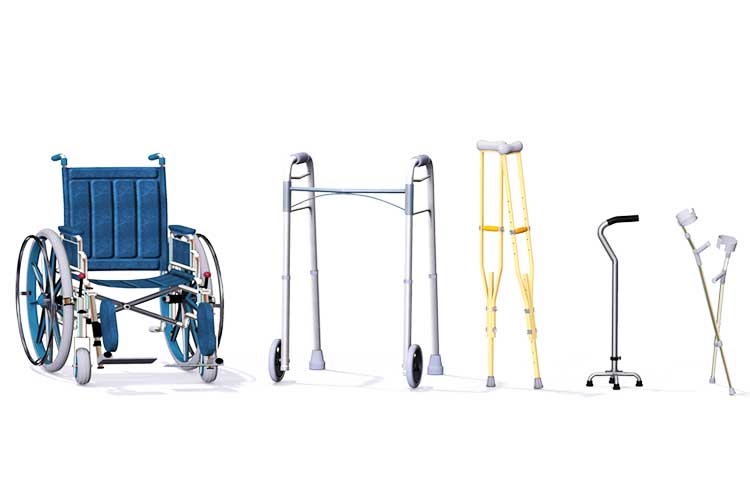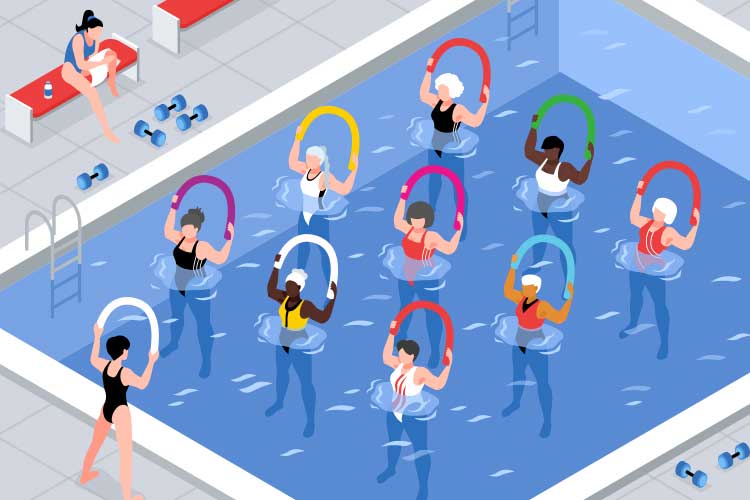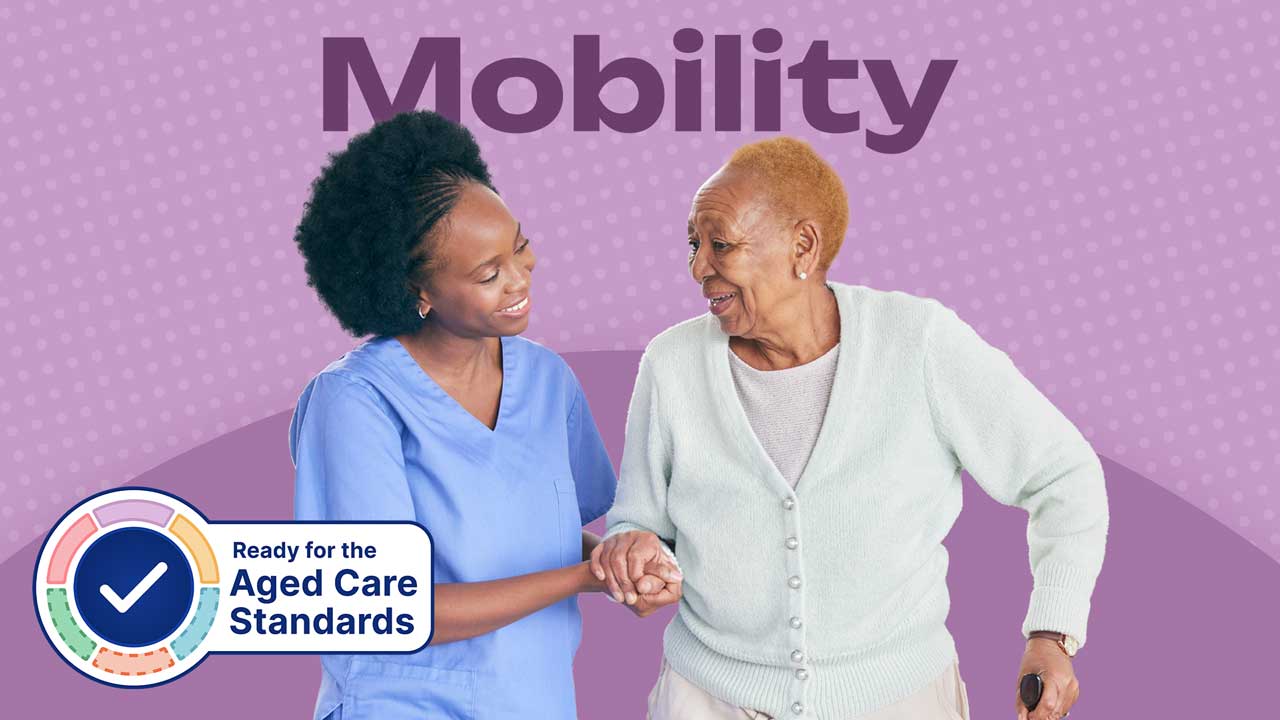There are many considerations to keep in mind when caring for an older person who lives with impaired or limited mobility.
Why is Mobility Important?
Mobility is closely tied to our sense of independence, but also our social connectedness, activity and security (Health.vic 2015a). A person's wellbeing can be considerably compromised by a mobility restriction.
Mobility issues become more of a concern with age, and in many cases, older people must face a period of adjusting from complete independence to suddenly relying on others for even minor tasks, such as brushing their teeth or basic grooming.
Mobility impairment can range from limitations of stamina to total paralysis (Illinois University Library 2023).
Often, a lack of functional mobility can contribute to health issues such as falls, incontinence, and malnutrition (Health.vic 2015a).
Mobility Under the Strengthened Aged Care Quality Standards
Under Standard 5: Clinical Care - Outcome 5.5: Clinical Safety (Action 5.5.4) of the strengthened Aged Care Quality Standards, aged care providers are required to reduce falls and harm from falls by optimising older people’s mobility to prevent functional decline (ACQSC 2024).

The Effects of Facilitating Mobility and Self-Care
By encouraging and helping an older person to achieve or regain mobility, the risk of the following decreases:
- Depression
- Delirium
- Malnutrition
- Falls and fall-related injuries
- Loss of confidence due to fear of falling.
(Health.vic 2015a)
The Effects of Long-term Bed Rest Due to Mobility Restriction
In a situation in which drastically reduced mobility results in bed rest, there is a heightened risk of additional health complications:
Cardiovascular
- Postural hypotension
- Reduced aerobic capacity.
Respiratory
- Reduction in arterial oxygen level
- Increased potential for atelectasis.
Musculoskeletal
- Reduced muscle mass
- Reduced muscle strength
- Muscle shortening
- Joint contractures
- Reduced bone density
- Increased risk of falls/injury
- Pain.
Gastrointestinal
- Constipation
- Malnutrition.
Genitourinary
- Continence issues.
Skin
- Breakdown in skin integrity.
Psychological
- Confusion
- Social isolation
- Depression.
(Health.vic 2015a)
What is ‘Functional Mobility’?
Functional mobility is the capacity to move from one position to another, enabling participation in everyday life.
- Bed mobility
- Transfers
- Walking
- Wheelchair mobility
- Accessing toilets
- Getting in and out of a car
- Driving and taking public transport.
(Health.Vic 2015b)
Mobility restrictions and the use of gait aids can significantly impact a person’s ability to access their home and local area. This can cause difficulty maintaining and initiating social connections within their community (Health.vic 2015c).
Mobility Aids

Read: Understanding Mobility Aids
Mobility aids are pieces of equipment that facilitate movement for people who would otherwise be unable or limited in their attempt to move, or participate in or carry out a task. Mobility aids include:
- Wheelchairs
- Walking frames
- Ramps
- Shower chairs
- Splints
- Braces
- Home oxygen services.
(Better Health Channel 2023)
Tips for Looking After an Older Person with a Mobility Impairment
There are small changes that can be made to help an older person living with a mobility restriction to move around. These include:
- Ensuring you know the person’s capacity (i.e. whether they can get out of bed on their own, how far they are able to walk, whether they need assistance).
- Always ensuring mobility aids are correctly adjusted to suit the person.
- Ensuring any tripping hazards such as furniture, mats and power cords are cleared from walkways. There should be enough unobstructed space for older people to move around safely, including those who use mobility aids.
- Ensuring the person’s bed is a suitable height.
- Ensuring mobility aids are able to fit through walkways.
- Looking out for wet or uneven flooring.
- Regularly checking mobility aids for damage (protruding or missing screws, split or loose hand grips, worn rubber tips etc.).
- Ensuring the person’s footwear is well-fitting, flat and non-slip.
(CEC 2017; Independent Living Centre 2019; Health.vic 2015c; Gramenz & Dymock 2023)
Exercise
Exercise programs can be delivered in individual or group settings and may include strength, balance, functional retraining, and aerobic exercises. Group classes facilitate social interaction and may help counteract loneliness and isolation (Health.vic 2015c).
The exercise undertaken by older people with mobility limitations does not need to be strenuous. Research has shown that even minor increases in movement can make a difference in physical ability and prevent the likelihood of falls in people over the age of 65 (Aged Care Guide 2014).
Recommend that, if they are able, older people incorporate balance and strength training into their daily routines - examples include taking the stairs more often and balancing on one leg while brushing their teeth (Aged Care Guide 2014).
Informed by rigorous study, this approach to exercise has been shown to reduce falls by more than 30% (Aged Care Guide 2014).
Another way of exercising is through incidental activity - physical activity that occurs as part of a daily routine. Examples include:
- Getting out of bed
- Walking to the toilet
- Getting dressed
- Eating meals outside of bed
- Showering and grooming.
(Health.vic 2015c)
As well as facilitating exercise, incidental activity is also beneficial in encouraging self-care (Health.vic 2015c).
These activities can be performed with supervision or assistance if required (Health.vic 2015c).

Falls Prevention
Every year, one in four older people experiences a fall (Healthdirect 2023). From 2019 to 2020 alone, over 133,000 older people were admitted to the hospital due to a fall (AIHW 2022).
Falls in older people are commonly associated with functional decline and loss of confidence, negatively impacting their mobility (Health.vic 2015d).
Despite this, falls are often preventable (Health.vic 2015d).
Using some of the strategies above can help to reduce the risk of falls.
Conclusion
A mobility impairment has the potential to severely impact the wellbeing of an older person, causing isolation, fear of falling, increased bed rest and dependency on others for simple tasks. Limited mobility can be navigated through accessible home environments, support and exercise programs.
Test Your Knowledge
Question 1 of 3
Which one of the following is an example of incidental activity?
Topics
Further your knowledge
References
- Aged Care Guide 2014, ‘Get Creative with Exercise for Older People’, Aged Care Guide, 17 September, viewed 13 May 2024, https://www.agedcareguide.com.au/talking-aged-care/get-creative-with-exercise-for-residents
- Aged Care Quality and Safety Commission 2024, Standard 5: Clinical Care, Australian Government, viewed 13 May 2024, https://www.health.gov.au/resources/publications/strengthened-aged-care-quality-standards-august-2025?language=en
- Australian Institute of Health and Welfare 2022, Falls in Older Australians 2019–20: Hospitalisations and Deaths Among People Aged 65 and Over, Australian Government, viewed 13 May 2024, https://www.aihw.gov.au/reports/injury/falls
- Better Health Channel 2023, Aids and Equipment at Home, Victoria State Government, viewed 13 May 2024, https://www.betterhealth.vic.gov.au/health/servicesandsupport/aids-and-equipment-at-home
- Clinical Excellence Commission 2017, Pointers for Safe Mobilisation - Give it a Go!, New South Wales Government, viewed 13 May 2024, http://cec.health.nsw.gov.au/__data/assets/pdf_file/0009/399690/Pointers-For-Safe-Mobilisation-Give-It-A-Go!.pdf
- Gramenz, J & Dymock, J 2023, How to Prevent Falls in Aged Care (& At Home), St Vincent’s Care, viewed 13 May 2024, https://www.svcs.org.au/residential-aged-care/information/how-to-prevent-falls
- Health.vic 2015d, Falls, Victoria State Government, viewed 13 May 2024, https://www.health.vic.gov.au/patient-care/falls
- Health.vic 2015c, Maintaining and Improving Mobility and Self-care, Victoria State Government, viewed 13 May 2024, https://www2.health.vic.gov.au/hospitals-and-health-services/patient-care/older-people/falls-mobility/mobility/mobility-improving
- Health.vic 2015a, Mobility and Self-Care Support Independence, Victoria State Government, viewed 13 May 2024, https://www2.health.vic.gov.au/hospitals-and-health-services/patient-care/older-people/falls-mobility/mobility/mobility-independence
- Health.vic 2015b, Understanding How Patients Move, Victoria State Government, viewed 13 May 2024, https://www2.health.vic.gov.au/hospitals-and-health-services/patient-care/older-people/falls-mobility/mobility/mobility-understanding
- Healthdirect 2023, Older People and Falls, Australian Government, viewed 13 May 2024, https://www.healthdirect.gov.au/falls
- Illinois University Library 2023, What is a Physical/Mobility Disability?, University of Illinois, viewed 13 May 2024, https://guides.library.illinois.edu/physicalmobilityimpairments
- Independent Living Centre 2019, Walking Aids: Using and Measuring, Government of South Australia, viewed 13 May 2024, https://www.scribd.com/document/508946000/walking-aids-using-and-measuring
 New
New 

